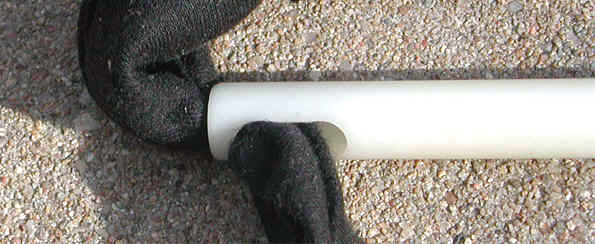Introduction
Don't you always worry about the ring of moisture left inside your flute head
after swabbing out - the bit near the stopper that the regular cleaning stick
can't get to - the very part of the flute that needs cleaning most! Yes,
I've tried folding the cloth over the tip of a regular rod and it still doesn't
get into the corner, and I've tried the miniature bottle brushes you buy for
recorders and they don't either! It's been bugging me, and I think I've
come up with a good answer.
D.I.Y.
Now this is something you can make yourself. Take a piece of
the largest rod (wooden dowel, plastic, gold, whatever you have
lying around) that will pass easily through the narrowest section
of your flute. Cut off a piece as long as will fit conveniently
into your flute case. Face up one end and remove the sharp edges
to be comfortable in the hand. Put a mark 3/4" (19) mm from
the end to show where the stopper should be.
(In the ones I make, I actually put three inscribed rings at:
- 19mm, the modern "rule-of-thumb" starting point for stopper placement,
- 15mm, about the minimum location you might need to give best third
octave performance, and
- 23mm, where some players find a better low end performance.
Players are encouraged to experiment with these and intermediate locations to
come to their own conclusion about what suits their playing style best.)
Face off the other end and drill a hole into it for about 3/4"
(19mm). Make the hole as large as possible consistent with not
making the end too weak. Now take a scoop out of the side of the
rod, near enough to the end to meet up with the hole you've just
drilled. Clean up all the edges and you're ready to go.

Improved cleaning rod, in white delrin, showing
the side slot
To use the cleaning rod, cut a piece of absorbent cloth (old T-shirt
material is good) about 150 x 50 mm (6 x 2"). Twist up one
end and feed it into the hole on the end of the rod. Pull it
firmly out through the slot you scooped out and leave about half
sticking out each way. Fold the protruding bit over the end and
down the side of the stick.
Test it in the barrel first to make sure you don't have too
much cloth, and then in the head. Rotate it a few times against
the stopper before pulling it out - you should find it leaves
very little moisture.
Test it carefully on the rest of the flute. It will probably
pass head-first through the upper body, and can be used tail-first
on the bores of the lower section and foot. When in doubt, try
inserting it into the narrow end first.
And if you don't feel like making one, I can supply you with
one with your next flute!
Postscript
Harry Egnor, flute player and Technical Field Manager, Audi of America,
writes:
I recently purchased a GLP from Grey Larsen, and have a Rudall Perfected
of yours as well, so I decided to purchase one of your improved cleaning
rods.
Initially I was a little disappointed because the 2”x6” inch patches I
cut from a “T” shirt would not go through the foot joint of the GLP, and
barely through that of the Rudall. Basically, the material was just
too thick. I tried making the patches smaller without success, and then I
got an idea...
I purchased a roll of cotton gauze 2’’ wide (the type used for bandages),
and cut off 6” lengths for my new patches. Now my patches worked
perfectly in both foot joints, was very absorbent, and very easy to cut to
size.
I hope you/your customers find this a useful “tip”.
I'm sure they will, Harry, indeed, I'm going to give it a go myself!
Thanks!
And, in the "Great Minds Thinking Alike" department ...
Roger Holman Enterprises is the source for Flute and Piccolo Flag brand swabs.
These swabs are a new approach to drying the bore of your instrument in
the least possible amount of time. Moisture is captured even at the face
of the head joint cork. Several varieties are currently available.
http://home.nethere.net/roger45/
Back to McGee Flutes
home page...
|